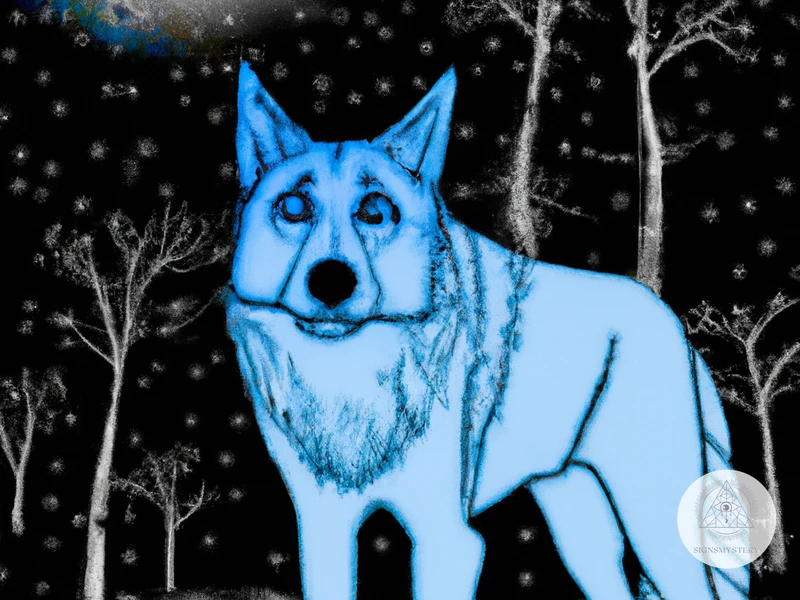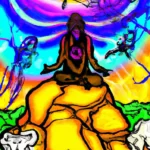Shamanism is an ancient spiritual practice that involves connecting with the natural world to facilitate healing and personal growth. With roots in many different cultures around the world, shamanic healing practices have been used for centuries to help individuals overcome physical, emotional, and spiritual challenges. There are many different types of shamanic healing practices, each with its own unique set of techniques and benefits. In this article, we will explore some of the most common shamanic healing practices, including core shamanism, soul retrieval, power animal retrieval, shamanic journeying, and plant medicine, to gain a better understanding of how these practices can aid in our overall well-being and spiritual development.
Core Shamanism

Core Shamanism is a practice that is rooted in ancient traditions, but it has been adapted for modern times. It focuses on the individual’s ability to connect with the spiritual world and introduces them to the core shamanic practices. These practices involve various techniques such as drumming, dancing, and meditation, allowing the individual to access ecstatic states of consciousness. Core Shamanism emphasizes the use of a shamanic journey as a tool to connect with the spiritual realm for healing and guidance. From there, the individual can receive insights and messages from their spirit guides or other spiritual beings, which can help them overcome their challenges or problems. Core Shamanism can be a powerful tool for promoting spiritual growth and personal transformation. Don’t forget to check out our shamanic healing basics page for more information on the role of shamanic healing.
What is Core Shamanism?
Core Shamanism is a modern approach to shamanism that was established by anthropologist Michael Harner. It is based on the traditional shamanic practices of indigenous peoples from all over the world, but with some modifications to make it accessible to Westerners.
Unlike some traditional shamanic practices that are specific to certain cultures, Core Shamanism is not tied to any particular culture or religion. It is a universal and adaptable set of practices that focus on the commonalities of shamanic experience.
Core Shamanism involves the use of drums, rattles, and other instruments to induce a trance state that allows the shaman to journey to non-ordinary reality, where they can communicate with spirits, retrieve information, and perform healing.
Core Shamanism emphasizes personal experience and direct revelation, encouraging each individual to develop their own relationship with the spirit world. It also places a strong emphasis on ethics and personal responsibility, with the understanding that the power of the shaman comes with great responsibility.
Some of the key practices in Core Shamanism include journeying, divination, power animal retrieval, soul retrieval, and psychopomp work.
Core Shamanism can be seen as a way of accessing the deeper truths and wisdom that lie beyond the material world, connecting with spiritual allies, and harnessing spiritual power to promote healing and growth.
Internal link: Role of Shamans in Healing
How is Core Shamanism Practiced?
Core Shamanism involves a set of practices that are aimed at establishing a connection with the spiritual world, for the purpose of healing and guidance. Core Shamanism is practiced through the following techniques:
| Technique | Description |
|---|---|
| Drumming | Drumming is used to induce a trance-like state in the shaman or the patient. The drumbeat creates a rhythmic sound that helps the shaman access the spiritual world. |
| Dancing | In some shamanic traditions, dancing is used to induce a trance-like state. The shaman may use various movements and gestures to communicate with the spiritual world. |
| Meditation | Meditation is used to clear the mind and achieve a state of inner peace. The shaman may use this technique to connect with the spiritual world or to guide the patient through a healing process. |
| Visualization | The shaman may use visualization techniques to journey to the spiritual world or to help the patient visualize a state of healing. |
| Rituals | Rituals may involve the use of objects or symbols to connect with the spiritual world. These rituals may be performed in a group or individually. |
These techniques are often combined in a shamanic healing session. The shaman may use any of these techniques to connect with the spiritual world and receive guidance and healing. The patient may also be encouraged to try some of these techniques on their own, to continue their healing outside of the session.
It’s important to note that while these techniques are used in Core Shamanism, they may also be used in other shamanic traditions. It’s essential to seek out a qualified shamanic practitioner who can guide you through a healing process and ensure that proper techniques and ethical practices are followed. For more about the ethics of shamanic healing practices, please see our guide on the topic.
Benefits of Core Shamanism
Core Shamanism is an effective and powerful healing practice that has several benefits. Some of the benefits are:
| Benefit | Description |
| Heals physical pain | Core Shamanism may help manage and relieve physical pain. It works by identifying and eliminating the root cause of the pain and using spiritual methods to heal the body. |
| Improves mental and emotional well-being | Core Shamanism can reduce anxiety and stress, relieving symptoms of depression and other mental health conditions. It can also help improve emotional regulation and provide clarity and a sense of purpose. |
| Helps with trauma healing | Core Shamanism may be a helpful addition to trauma healing work. By accessing non-ordinary reality, individuals can address and heal traumas, past and present, in a safe and effective way. |
| Reduces negative energy | Core Shamanism can help get rid of negative energy and promote positivity in an individual’s life. Negative energy may manifest as physical, mental, and emotional pain and may be a manifestation of spiritual disharmony. |
Core Shamanism enables individuals to connect with their inner wisdom and divine guidance in a way that can help them lead a more fulfilling life. It blends ancient spiritual traditions with modern perspectives, providing an effective way to promote self-awareness, healing, and personal growth. Its benefits can also be enhanced by combining it with other healing practices such as power plant medicines, shamanic journeying, and other shamanic techniques.
Soul Retrieval
Soul Retrieval is a shamanic healing practice that involves bringing back lost parts of a person’s soul, which may have been lost due to traumatic experiences or other reasons. During this process, a shamanic practitioner enters a trance state to access non-physical realms and communicate with spirits. The process involves identifying the lost soul parts and retrieving them with the help of a spirit guide. Soul Retrieval is an effective practice for individuals struggling with depression, addiction, and post-traumatic stress disorder. This technique can be used in conjunction with other shamanic practices to address specific issues such as physical pain or mental and emotional well-being. It can also help to release negative energy that may be stored in the body.
Understanding Soul Retrieval
Soul Retrieval is one of the most ancient shamanic healing practices that aims to retrieve parts of the soul that were lost. In indigenous cultures, it is believed that a person’s soul is comprised of different parts, which might become lost or fragmented due to traumatic experiences, illness, or other forms of shock. Soul loss can result in symptoms such as depression, chronic illness, or addiction.
During a Soul Retrieval session, the shamanic practitioner enters a trance state and journeys to the lost soul parts to retrieve them and bring them back to the person’s body. The process of Soul Retrieval is different for each individual as it depends on the cause of the soul loss. Some people might have lost their soul parts due to emotional trauma, while others might have lost them because of physical illness.
It is important to note that Soul Retrieval is not a replacement for professional medical care, and it should not be viewed as a stand-alone treatment for any condition. It is typically used as a complementary treatment to other forms of therapy, or as a preventive measure to maintain good mental and emotional health.
Soul Retrieval can be a transformational experience for those who undergo it. It can help individuals regain their sense of vitality and purpose, which might have been lost due to soul loss. The process can be emotionally intense, and it is important for the individual to have support and guidance from a trained shamanic practitioner throughout the process.
If you would like to know more about how shamanic techniques can help with healing trauma, you can check out our article “Healing Trauma with Shamanic Techniques“. For more information on how shamanic healing can help with physical pain, check out our article “Shamanic Healing for Physical Pain“. If you’re interested in how shamanic healing can improve mental and emotional well-being, read our article “Shamanic Healing for Mental and Emotional Well-Being“. And if you’re curious about how shamanic healing can help with negative energy, read our article “Clearing Negative Energy with Shamanic Healing“.
How is Soul Retrieval Done?
Soul retrieval is a shamanic healing practice that involves retrieving lost parts of the soul. The process of soul retrieval is done in the following steps:
1. Consultation and preparation: This step involves meeting with the shamanic practitioner to discuss your situation and intentions for the session. The practitioner will also provide guidance on how to prepare yourself for the journey and what to expect during and after the session.
2. Journeying: The shamanic practitioner will enter a trance-like state and journey to the spiritual realm to retrieve the lost parts of your soul. During this process, the practitioner may use drumming, rattling, or chanting to enter the altered state of consciousness needed for the journey.
3. Retrieval: Once the lost parts of the soul have been identified, the shamanic practitioner will retrieve them and bring them back to the client. This may involve negotiating with spiritual beings in the spiritual realm and dealing with any obstacles or challenges that arise.
4. Integration: After the lost parts of the soul have been retrieved, the shamanic practitioner will help the client integrate them back into their being. This involves helping the client process any emotions or experiences that arise from the journey and finding ways to incorporate the retrieved soul parts into their daily life.
Soul retrieval is a powerful healing practice that can help individuals regain a sense of wholeness and connection to themselves and the world around them. It is important to find a qualified and experienced shamanic practitioner to guide you through the process and provide support before, during, and after the session.
Why is Soul Retrieval Important?
Soul retrieval is an important aspect of shamanic healing that has been practiced for thousands of years. It aims to restore and integrate lost parts of one’s soul essence, which could have been detached due to traumatic experiences, soul loss, or other factors.
Importance of Soul Retrieval
Many people may not even realize that they have lost a part of themselves, but it can manifest as a sense of emptiness or feeling incomplete. In shamanic beliefs, a person’s soul is believed to be a complete and interconnected entity comprising different aspects, including the self, vital force, essence, and spirit. When parts of one’s soul are lost or fragmented, it can affect them in various ways, including;
– Feeling disconnected from one’s self and others
– Depression and a sense of worthlessness
– Anxiety and fear
– Addictive tendencies
– Chronic illnesses and diseases
Soul retrieval is essential for one’s overall well-being and healing. Through the retrieval process, one can regain the lost parts of their soul, which can result in;
– Feeling more connected to oneself and others
– Increased self-awareness and self-love
– Improved emotional, mental, and physical well-being
– Greater clarity and purpose in life
– Enhanced creativity and intuition
– Freedom from addictive tendencies and patterns
In essence, soul retrieval is a way of reclaiming and integrating parts of oneself that have been lost or forgotten due to life experiences. It is a transformative process that can lead to a deeper understanding of one’s self and a renewed sense of wholeness.
Power Animal Retrieval

Power Animal Retrieval is a shamanic healing practice that involves finding and connecting with a spirit animal that serves as a guide, protector, and source of guidance for an individual. In this practice, a shamanic practitioner enters a trance state to journey into the spiritual world to encounter a power animal that offers wisdom, support, and guidance to the person in need. The process of retrieving a power animal involves patience, trust, and a willingness to open oneself to the spiritual realm. One of the crucial benefits of Power Animal Retrieval is that it helps people to connect with their inner selves, their emotions, and their innate strength by fostering a deep sense of grounding, protection, and support that can improve their life in many ways. Power Animal Retrieval is a transformative and empowering shamanic practice that can help individuals to tap into their innate power and find healing and guidance when they need it most.
What is a Power Animal?
A power animal is an essential element of shamanic healing. It is a spirit animal that serves as a guide or protector to the person during their lifetime. This animal could be a real-life animal like a dog or a bird, or it could be a mythical creature like a dragon or unicorn. In shamanic traditions, each person has their own power animal that assists them in their spiritual journey through life.
The power animal represents certain qualities and characteristics that the person needs to embrace to live their best life. For example, a person with a lion power animal may need to embrace courage and strength, while a person with a butterfly power animal may need to embrace transformation and change.
Power animals are believed to be wise and compassionate spirits that can offer guidance, protection, and healing. They are seen as teachers who have a lot to teach humans about the world and how to navigate through it. Power animals are also believed to be able to travel between the spiritual and physical realms, making them powerful allies in shamanic healing.
Connecting with a power animal requires a shamanic journey, where the person enters a trance-like state to visit the spirit realm. During this journey, the person may encounter their power animal, who will offer them guidance or healing. This encounter can be a life-changing experience as it can lead to a deeper understanding of oneself and one’s place in the world.
A power animal is an important aspect of shamanic healing. It is a spirit animal that serves as a guide and protector to the person throughout their lifetime. Each person has their own power animal that represents certain qualities and characteristics that they need to embrace to live their best life. Connecting with one’s power animal requires a shamanic journey, which can be a transformative experience.
How is a Power Animal Retrieved?
Power Animal Retrieval:
Power animals are spirit guides that assist individuals in their spiritual journey. Retrieving a power animal is an essential part of shamanic healing. The process of retrieving a power animal involves a shamanic journey.
- The client and shaman set the intention for the journey and begin to call on the power animal to come forward.
- Shamanic drumming or rattling is used to create a trance-like state in which the shaman and client can travel to the spirit world.
- Once in the spirit world, the shaman may encounter multiple power animals on behalf of the client. They will carefully observe each animal and speak with them to determine which one is the client’s power animal.
- Once the power animal is identified, the shaman will bring it back to the client and merge it with their energy field.
During the process of power animal retrieval, the shaman must be careful to choose the right power animal for the client. The power animal will become a guardian and guide for the client throughout their life. The shaman will also work with the client to teach them how to connect and communicate with their power animal. This connection allows the client to draw strength and guidance from their power animal whenever they need it.
Benefits of Power Animal Retrieval:
The retrieval of a power animal can provide significant benefits for an individual, including:
- Increased sense of protection and safety
- Better connection to nature and the environment
- Greater self-awareness and understanding
- Expanded personal power and inner strength
- Improved mental and emotional well-being
- Heightened intuition and spiritual insight
Retrieving a power animal is a powerful shamanic healing practice that can be transformative for individuals seeking spiritual growth and guidance.
Benefits of Power Animal Retrieval
The benefits of power animal retrieval in shamanic healing are truly remarkable. First and foremost, having a strong and reliable power animal can give a person a sense of grounding and protection. This is especially important for those who are feeling lost, fearful, or uncertain about their place in the world. A power animal can serve as a source of strength and confidence, helping a person to feel more secure and empowered in their daily life.
Additionally, a power animal can provide valuable guidance and insights. Many people report receiving guidance from their power animals during difficult times or when facing important decisions. These insights often come in the form of messages or symbols that are communicated through dreams, visions, or other means. By working with a power animal, a person can gain a deeper understanding of themselves and the world around them.
Power animal retrieval can also be helpful in releasing and healing emotional wounds. Trauma, stress, and other negative experiences can leave energetic imprints on a person’s psyche, which can manifest as physical or emotional pain. By working with a power animal, a person can gain access to the healing powers of nature and begin to release these imprints, creating a sense of freedom and peace.
Power animal retrieval is a powerful and transformative practice that can bring a variety of benefits to those who are open to it. Whether you are seeking protection, guidance, healing, or simply a deeper connection with nature, working with a power animal can be a truly life-changing experience. So if you’re looking to explore the world of shamanic healing, be sure to consider the many benefits of power animal retrieval.
Shamanic Journeying
Shamanic journeying is a powerful shamanic healing practice that involves traveling to non-ordinary reality to communicate with spirits and receive guidance. During a shamanic journey, the shaman or practitioner uses rhythmic drumming or other percussive instruments to alter their consciousness and enter a trance state. Once in this state, they can embark on
Subscribe to Our Newsletter
Sign up to receive the latest news and updates.
What is a Shamanic Journey?
A Shamanic Journey is a method of exploring the spiritual realm and gaining insight, wisdom and healing from higher powers and spirit guides. It is a form of meditation that involves entering a trance state to connect with the spirit world. Shamanism holds the belief that spiritual knowledge is available to everyone, and the world is interconnected. The journey can be taken to address a particular issue or gain guidance on a particular subject.
A shamanic journey is a form of guided visualization where the shaman or the practitioner leads the journey through different realms or worlds which are also known as the three worlds: the upper world, the middle world, and the lower world. The upper world is where spirit guides, ancestors, and deities reside. The middle world is where the practitioner can communicate with the spirits of nature like animals, trees, and plants. The lower world is where the spirits of the deceased, chthonic, and underworld beings reside.
The journey starts by setting an intention to connect with the spirits and then entering into a meditative state using breathing techniques, drumming, or rattling. The shamanic practitioner guides the journey by providing a script, which acts as a map for the journey. The script usually starts with entering into a portal and then moving through different worlds, meeting various spiritual beings and gaining wisdom and insight.
A shamanic journey can be done alone or in a group, and the experience is unique to every individual. It is a way of connecting with your higher self, receiving answers to your questions, and receiving healing. It allows you to access the wisdom and guidance of the spirit world, and bringing that into your everyday life.
A shamanic journey is a powerful meditative practice that allows individuals to explore the spiritual realm and gain insight, wisdom, and healing from higher powers and spirit guides. By connecting with the spirit world, individuals can access knowledge and guidance to improve their lives and bring transformation to themselves and others.
How is a Shamanic Journey Done?
A shamanic journey is a way to connect with one’s inner self and communicate with the spirit world. Here are the steps on how a shamanic journey is done:
- Setting the intention: Before beginning the journey, one must set their intention for what they want to achieve and communicate with the spirits about.
- Entering a trance state: One must enter a trance-like state using various techniques including drumming, rattling, or chanting. This will allow them to enter a meditative state conducive for shamanic journeying.
- Meeting with spirit guides: Once in a trance state, one can begin their journey by meeting with their spirit guides. These spirit guides could be one’s ancestors, power animals, or other helpful spirits.
- Exploring different realms: While journeying, one can explore different realms such as the lower world or upper world. These realms provide access to unique knowledge and experiences.
- Receiving messages: During the journey, messages and symbols may appear that provide guidance on the issue that one is seeking answers for. It is essential to be open to receiving these messages without judgment or interpretation.
- Returning to reality: After the journey is complete, one must make an effort to return to reality by giving thanks to their spirit guides and performing grounding activities such as deep breathing or connecting with nature.
Shamanic journeying is an effective way of connecting with one’s inner self and receiving guidance from the spirit world. It is a practice that requires openness, intention, and respect.
Benefits of Shamanic Journeying
Shamanic journeying is a powerful practice that has a wide range of benefits. One of the key benefits of shamanic journeying is its ability to provide deep insight and understanding into personal issues and challenges. By connecting with one’s spiritual guides and tapping into the wisdom of the universe, individuals can gain new perspectives on their situations and come away with a clearer sense of purpose and direction.
Another major benefit of shamanic journeying is its ability to promote healing on all levels- physical, emotional, mental, and spiritual. Through journeying, individuals can release old, negative patterns and blockages that have been holding them back, and open up to new, positive energies and possibilities. This can result in a profound sense of renewal and transformation, as well as increased health, vitality, and well-being.
Shamanic journeying can also be a profound tool for self-discovery and personal growth. By exploring the depths of one’s own psyche and connecting with one’s authentic self, individuals can gain greater self-awareness and develop a stronger sense of identity and purpose. This can lead to increased confidence, creativity, and overall fulfillment in life.
Shamanic journeying can be a powerful tool for developing intuition and psychic abilities. By regularly engaging in journeying practice, individuals can cultivate their abilities to sense and interpret energy, and develop a stronger connection to their spiritual guides and helpers.
The benefits of shamanic journeying are far-reaching and profound. Whether one is seeking personal growth, healing, or simply a deeper connection to the spiritual realm, journeying can provide an invaluable tool for transformation and empowerment.
Plant Medicine
Plant medicine has been used for centuries in shamanic healing practices around the world. The plants used in these practices are often referred to as teacher plants or master plants, and are believed to have a spiritual intelligence and the ability to communicate with humans. Shamanic practitioners use these plants in various ways, such as ingesting them as a tea, smoking them, or applying them topically. Each plant has its own unique properties and is believed to be helpful in treating different physical and emotional ailments. Some commonly used plants in shamanic healing include ayahuasca, peyote, and tobacco. While the use of plant medicine in shamanic healing can be powerful, it is important to approach it with caution and respect, and to seek guidance and support from a trained and experienced practitioner.
What is Plant Medicine?
Plant medicine refers to the use of plants and their medicinal properties to promote physical, emotional and spiritual healing. Throughout history, traditional healers have used a variety of plants for their healing properties. These plants are often consumed in various forms such as teas, tinctures, and extracts. Different parts of the plants, including the leaves, flowers, roots, and bark, may be used for their different medicinal properties.
The use of plant medicine is an ancient practice that has persisted throughout the world. In many indigenous cultures, plant medicine is an integral part of their spiritual and healing traditions. Plant medicine is believed to connect individuals with the spirit of the plant, allowing the plant to work its healing magic on the individual.
In recent years, the use of plant medicine in shamanic healing has gained popularity. Various plants are used in shamanic healing, including ayahuasca, peyote, and San Pedro cactus. These plants have psychoactive properties, which when used in a sacred context, can promote deep healing and transformation.
It is important to note that the use of plant medicine in shamanic healing should only be done under the guidance of an experienced shaman or healer. Improper use of these powerful plants can lead to physical and psychological harm.
Despite this caution, the use of plant medicine in shamanic healing offers a unique and powerful approach to healing. By connecting with the spirit of the plant, individuals are able to access profound insights and healing that may not be possible through other methods.
How is Plant Medicine Used in Shamanic Healing?
Plant medicine has been used in shamanic healing practices for centuries. It is believed that different plants have their unique abilities to heal both physical and spiritual diseases. Plant medicine is used in shamanic healing practices, not to provide a cure but to facilitate healing by increasing one’s own inner awareness to promote physical, emotional and spiritual health.
The use of plant medicine in shamanic healing is done in a ceremony led by a trained shamanic healer. The shaman administers certain plants in specific doses to induce a state of altered consciousness. The ceremony may involve drinking a brew, inhaling a smoke or applying botanical substances directly to the skin. The shaman then guides the person through the healing process, with the plant medicine working as a gateway to the spiritual realm to reconnect with one’s inner self.
The plant medicine used in shamanic healing ceremonies includes psilocybin mushrooms, ayahuasca, San Pedro cactus, and peyote. These plants contain psychedelic compounds that produce euphoria and mystical experiences and can offer insight into one’s life and health status.
During a shamanic healing plant medicine ceremony, one may experience intense physical and emotional effects. The person may encounter spiritual beings, have visions, or re-live past experiences through psychoactive effects. There can be moments of clarity and deep healing, and the shaman can provide guidance and insights to help integrate the experience and promote lasting change.
The use of plant medicine in shamanic healing practices is not suitable for everyone and should only be done under the guidance of a trained shamanic healer. The ceremony environment must be safe and conducive to the spiritual experience, and the plant must be administered under the right conditions to yield positive benefits.
In summary, plant medicine is an essential component of shamanic healing practices. By opening the doors of perception and connecting with the spiritual realm, plant medicine can facilitate healing on all levels, physical, emotional and spiritual. It is a powerful tool to promote inner awareness, enhance personal growth, and promote changes in one’s life to achieve a greater sense of well-being.
Benefits of Plant Medicine in Shamanic Healing
The use of plant medicine in shamanic healing has several benefits. Some of the benefits are:
- Physical healing: Many plant medicines have natural healing properties that can cure physical ailments. For example, Ayahuasca is used to detoxify the body and improve digestive health.
- Emotional healing: Plant medicine can help individuals overcome emotional traumas and psychological disorders. Ayahuasca and Peyote are known for their abilities to relieve depression, anxiety, and PTSD.
- Spiritual awakening: Plant medicines can induce spiritual experiences that can lead to self-realization and a better understanding of the universe. Ayahuasca and San Pedro are often used for spiritual purposes.
- Deeper connection with nature: Plant medicines encourage individuals to reconnect with nature and develop a deeper appreciation for all living things. This can lead to a greater sense of interconnectedness and environmental awareness.
It is important to note that the use of plant medicine should be done under the guidance of trained shamanic practitioners. Additionally, not all plant medicines are legal in all countries, so it is important to research and follow local laws and regulations before engaging in shamanic healing practices involving plant medicine.
Conclusion
In conclusion, the world of shamanic healing is vast and offers many different types of practices that one can explore. Whether it’s through core shamanism, soul retrieval, power animal retrieval, shamanic journeying, or plant medicine, each practice brings its unique benefits and experiences.
Core shamanism provides a foundation for all the other practices, offering a basic understanding of shamanic belief and techniques. Soul retrieval helps restore lost parts of the spirit and can provide healing for past traumas. Power animal retrieval is a great way to connect with animal spirits and gain strength from their wisdom. Shamanic journeying allows for exploration of different realms and can bring about insight and clarity. Finally, plant medicine can provide powerful healing for physical, emotional, and spiritual ailments.
It’s important to note that while shamanic healing practices have been used for centuries, they should not be seen as a substitute for modern medical care. It’s always best to consult with a healthcare professional before beginning any new healing regimen.
Overall, incorporating shamanic healing practices into your life can provide excellent benefits for physical, emotional, and spiritual well-being. Explore the different practices and find the ones that resonate with you and your needs. Trust the process and allow yourself to experience the transformative power of shamanic healing.
Frequently Asked Questions
What is shamanism?
Shamanism is an ancient spiritual practice that involves connecting with the spirit world to promote healing, balance and wellbeing.
Is shamanism a religion?
No, shamanism is not a religion. It is a spiritual practice that can be practiced by people of any religion or no religion at all.
Can anyone become a shaman?
Technically, yes. However, it takes years of training, practice and initiation to become a shamanic practitioner.
What happens during a shamanic healing session?
A shamanic healing session typically involves the shamanic practitioner journeying into the spirit world on behalf of the client to diagnose and treat the root cause of their illness or imbalance.
Are shamanic healing practices scientifically proven?
There is limited scientific research on shamanic healing practices, but many people have reported positive results from these practices.
What does soul retrieval mean?
Soul retrieval is a shamanic healing practice that involves recovering lost or fragmented parts of a person’s soul that have resulted from trauma or challenging life experiences.
What is a power animal?
A power animal is a spiritual entity that is believed to offer protection, guidance and support to an individual in the shamanic tradition.
What is a shamanic journey?
A shamanic journey is a meditative practice that involves entering an altered state of consciousness to connect with the spirit world and gain insight, wisdom and healing.
What is plant medicine in shamanic healing?
Plant medicine refers to the use of plants, herbs and other natural substances in shamanic healing practices to facilitate spiritual growth, healing and transformation.
Is shamanic healing right for everyone?
Shamanic healing is a personal journey, and what may work for one person may not work for another. It is important to approach these practices with an open mind and consult with a qualified shamanic practitioner before beginning.










